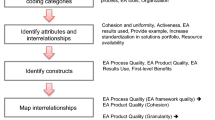Abstract
Artifact-centric approach to business process modeling has received considerable attention for elevating data logic to the same level as the process flow logic. With the emergence of this modeling paradigm, several recent works have focused on synthesizing the indispensable lifecycles of key business entities called artifacts from the standalone activity-centric processes. However, synthesizing artifact lifecycles from the inter-organizational business processes (IOBP) is challenging, as the artifacts and states are shared among two or more collaborating processes. Thus, unlike a standalone process, the synthesis of artifact lifecycles from an IOBP require the process interactions to be captured by preserving the dependencies between the involved artifacts and states in the resulting lifecycles. Therefore, in this paper, we propose an automated approach that aims at merging the collaborating processes of an IOBP in order to support the synthesis of artifact lifecycles from an IOBP. The proposed approach is comprised of algorithms that combine the nodes of collaborating processes to generate an integrated process that can be used to synthesize the artifact lifecycles pertinent to an IOBP. We demonstrate the proposed approach using an e-business process scenario and the validity is proved using theorems and a prototype implementation.








Similar content being viewed by others
Notes
Business Process Model and Notation, http://www.bpmn.org/.
In this paper, we use the terms process model and process interchangeably.
References
Assy N, Chan NN, Gaaloul W (2013) Assisting business process design with configurable process fragments. In: IEEE international conference on services computing. IEEE, pp 535–542
Bhattacharya K, Caswell NS, Kumaran S, Nigam A, Wu FY (2007) Artifact-centered operational modeling: lessons from customer engagements. IBM Syst J 46(4):703–721
Bulanov P, Lazovik A, Aiello M (2011) Business process customization using process merging techniques. In: IEEE international conference on service-oriented computing and applications (SOCA). IEEE, pp 1–4
Chao T, Cohn D, Flatgard A, Hahn S, Linehan M, Nandi P, Nigam A, Pinel F, Vergo J, y Wu F (2009) Artifact-based transformation of IBM global financing. In: International conference on business process management. Springer, pp 261–277
Chinnici R, Haas H, Lewis AA, Moreau JJ, Orchard D, Weerawarana S (2007) Web services description language (WSDL) version 2.0 part 2: adjuncts. W3C recommendation
Derguech W, Bhiri S (2011) An automation support for creating configurable process models. In: International conference on web information systems engineering. Springer, pp 199–212
Derguech W, Bhiri S, Curry E (2017) Designing business capability-aware configurable process models. Inform Syst 72:77–94
Eshuis R, Van Gorp P (2012) Synthesizing object life cycles from business process models. In: International conference on conceptual modeling. Springer, pp 307–320
Eshuis R, Van Gorp P (2016) Synthesizing object life cycles from business process models. Softw Syst Model 15(1):281–302
Gottschalk F, van der Aalst WM, Jansen-Vullers MH (2008) Merging event-driven process chains. In: OTM confederated international conferences on the move to meaningful internet systems. Springer, pp 418–426
Huang Y, Li W, Liang Z, Xue Y, Wang X (2018) Efficient business process consolidation: combining topic features with structure matching. Soft Comput 22(2):645–657
Kiepuszewski B, Ter Hofstede AH, Bussler CJ (2000) On structured workflow modelling. In: International conference on advanced information systems engineering. Springer, pp. 431–445
Kunchala J, Yu J, Sheng QZ, Han Y, Yongchareon S (2015) Synthesis of artifact lifecycles from activity-centric process models. In: IEEE 19th international enterprise distributed object computing conference. IEEE, pp 29–37
Kunchala J, Yu J, Yongchareon S, Han Y (2017) Towards merging collaborating processes for artifact lifecycle synthesis. In: Proceedings of the Australasian computer science week multiconference. ACM, p 50
La Rosa M, Dumas M, Uba R, Dijkman R (2013) Business process model merging: an approach to business process consolidation. ACM Trans Softw Eng Methodol 22(2):11
La Rosa M, Dumas M, Uba R, Dijkman R (2010) Merging business process models. In: OTM confederated international conferences on the move to meaningful internet systems. Springer, pp 96–113
Liu R, Wu FY, Kumaran S (2010) Transforming activity-centric business process models into information-centric models for soa solutions. J Database Manag 21(4):14–34
Mendling J, Simon C (2006) Business process design by view integration. In: International conference on business process management. Springer, pp 55–64
Meyer A, Weske M (2013) Activity-centric and artifact-centric process model roundtrip. In: International conference on business process management. Springer, pp 167–181
Nigam A, Caswell NS (2003) Business artifacts: an approach to operational specification. IBM Syst J 42(3):428–445
Schunselaar DM, Leopold H, Verbeek HM, van der Aalst WM, Reijers HA (2014) Configuring configurable process models made easier: an automated approach. In: International conference on business process management. Springer, pp 105–117
Sun S, Kumar A, Yen J (2006) Merging workflows: a new perspective on connecting business processes. Decis Support Syst 42(2):844–858
Xu W, Su J, Yan Z, Yang J, Zhang L (2011) An artifact-centric approach to dynamic modification of workflow execution. In: OTM confederated international conferences on the move to meaningful internet systems. Springer, pp 256–273
Yongchareon S, Liu C, Zhao X (2012) A framework for behavior-consistent specialization of artifact-centric business processes. In: International conference on business process management. Springer, pp 285–301
Yongchareon S, Yu J, Zhao X (2015) A view framework for modeling and change validation of artifact-centric inter-organizational business processes. Inform Syst 47:51–81
Zemni MA, Mammar A, Hadj-Alouane NB (2016) An automated approach for merging business process fragments. Comput Ind 82:104–118
Acknowledgements
This work is supported in part by Key Project of the National Natural Science Foundation of China (Nos. 61832004 and 61672042).
Author information
Authors and Affiliations
Corresponding author
Additional information
Publisher's Note
Springer Nature remains neutral with regard to jurisdictional claims in published maps and institutional affiliations.
Rights and permissions
About this article
Cite this article
Kunchala, J., Yu, J., Yongchareon, S. et al. An approach to merge collaborating processes of an inter-organizational business process for artifact lifecycle synthesis. Computing 102, 951–976 (2020). https://doi.org/10.1007/s00607-019-00770-z
Received:
Accepted:
Published:
Issue Date:
DOI: https://doi.org/10.1007/s00607-019-00770-z
Keywords
- Artifact-centric modeling
- Inter-organizational business process
- Process merging and interaction patterns




